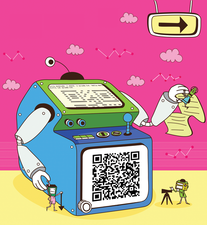Creating and reading QR codes
Simplified

With the right tools, you can create your own QR code squares with information you want to share, for example, on a business card, in a letter, or on your website.
Read errors of unreliable, one-dimensional bar codes often caused interruptions in industrial production, prompting companies like Toyota and its subsidiary Denso Wave to develop as early as 1994 a new code for acquiring stock data. The new matrix bar code was designed to store more information than the traditional bar code and to stay legible, even if the label was dirty, wrinkled, or partially destroyed.
The quick response code, or QR code, comprises a matrix of square dots instead of the usual lines. Measuring up to 177 by 177 dots, the QR code encodes up to 4,296 characters, compared with a bar code that encodes just 13.
Thanks to numerous free reader apps for smartphones, QR codes have gained in popularity in recent years. Posters, catalogs, magazines, business cards, and even television screens display the small squares, offering additional information or URLs for microsites.
[...]
Buy this article as PDF
(incl. VAT)
Buy Linux Magazine
Subscribe to our Linux Newsletters
Find Linux and Open Source Jobs
Subscribe to our ADMIN Newsletters
Support Our Work
Linux Magazine content is made possible with support from readers like you. Please consider contributing when you’ve found an article to be beneficial.

News
-
SUSE Dives into the Agentic AI Pool
SUSE becomes the first open source company to adopt agentic AI with SUSE Enterprise Linux 16.
-
Linux Now Runs Most Windows Games
The latest data shows that nearly 90 percent of Windows games can be played on Linux.
-
Fedora 43 Has Finally Landed
The Fedora Linux developers have announced their latest release, Fedora 43.
-
KDE Unleashes Plasma 6.5
The Plasma 6.5 desktop environment is now available with new features, improvements, and the usual bug fixes.
-
Xubuntu Site Possibly Hacked
It appears that the Xubuntu site was hacked and briefly served up a malicious ZIP file from its download page.
-
LMDE 7 Now Available
Linux Mint Debian Edition, version 7, has been officially released and is based on upstream Debian.
-
Linux Kernel 6.16 Reaches EOL
Linux kernel 6.16 has reached its end of life, which means you'll need to upgrade to the next stable release, Linux kernel 6.17.
-
Amazon Ditches Android for a Linux-Based OS
Amazon has migrated from Android to the Linux-based Vega OS for its Fire TV.
-
Cairo Dock 3.6 Now Available for More Compositors
If you're a fan of third-party desktop docks, then the latest release of Cairo Dock with Wayland support is for you.
-
System76 Unleashes Pop!_OS 24.04 Beta
System76's first beta of Pop!_OS 24.04 is an impressive feat.

